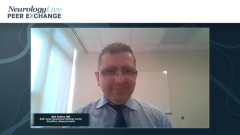
Future Directions for the Management of Migraine
Bradley Torphy, MD, and Julio R. Vieira, MD, share unmet needs and clinical pearls for the management of migraine.
Episodes in this series

Jessica Ailani, MD: Brad, what do you suggest when you talk to patients about controlling their disease progress and helping to reduce the progression of disease? How do you have that conversation? And how would you suggest our listeners discuss these points with the patients who are sitting in front of them?
Bradley Torphy, MD: We could take 2 main avenues when we think about progression. There are data that we all know about that say if there's optimized acute treatment of migraine, there's less likelihood of transformation to chronic migraine. And what does optimized acute therapy look like? I share this with my patients. The FDA [United States Food and Drug Administration] has stated that acute treatments for migraine need to look at pain freedom at 2 hours, pain relief at 2 hours, and absence of the most bothersome symptom, whether that's light sensitivity, sound sensitivity, or nausea. And I would challenge patients, if you're not experiencing at least pain relief—and let's aim for pain freedom at 2 hours—then I think, have that discussion with your provider if they're not optimizing your treatment. And then the other piece—the kind of layers on top of this—is to stay engaged. We know that there can be a variety of factors. Those factors could change over time. But if a patient has an introspective look to say, OK, is stress playing a role in my migraine? I share with my patients, let's try to control what we can control. We can't control the weather. If weather changes are triggering migraine, then that's going to be a challenge. But if we know the red wine is a trigger, well, then let's avoid that. But if stress is a trigger, then whether it's mindfulness, whether it's seeing a psychologist, a therapist, or maybe it's exercise, just continue to have that reflection and know that these triggers can change over time. But staying engaged is very helpful.
Jessica Ailani, MD: That's a great piece of advice. When possible, just stay engaged and focus on what you can fix; don't focus on what is not changeable to some degree. Julio, what about unmet needs and future directions of treatment in patients with migraine? What are some of the areas that are not met right now?
Julio R. Vieira, MD: One of the things that all of you guys kind of touched into is that every time when I'm going to discuss a treatment with my patients, I try to tell them that there are usually 3 different things that we need to address. On treatment, we need to address acute medication, acute therapy, or prevention therapy, and lifestyle modification. And sometimes several things in the lifestyle modifications are not addressed, sleep being 1 of them, which can make such a huge difference in patients. Mood and, like Sait was saying, other nonpharmacological therapies that address those issues are so useful. And also to think about it as not a competition. One of them does not supplant the other ones or do they all have to intertwine. And your treatment has have the holistic approach of the patient as a whole. Ideally, patients seek to have methods of treatment that are effective, well tolerated, are quick, and long-lasting. Fortunately, we have so many different medications. The advance in headache medicine in the past few years has been tremendous, which is great to have, all those new medications that came out onto the market and all the other ones they are out in the pipeline. They increased our tools in our toolbox to treat patients. Unfortunately, despite us clinicians having the best interest in our patients at hand, sometimes we must face insurance companies that are not willing to think the same way that we are thinking. Like you address, Jessica, that instead of going with failing 2 medications, certain insurances give you the A through Z that you have to fail before you get to a specific medication. The triviality of this sometimes is boring and annoying, but it's very good that now we have those 2 consensus statements that we can use and try to improve approval of medications which are migraine-specific to our patients, and not borrow medication that we've been using to treat other conditions. Having this approach and also educating other clinicians, general neurologists, primary care, and spreading our knowledge, and trying to engage more and more people and also patient advocates too. They make such a difference to spread the knowledge and having groups that we have available throughout the country as well.
Jessica Ailani, MD: That’s a great answer. It is a fun time to work in this field and you don’t have to be a headache specialist to get the enjoyment of making these patients feel much better and improve their quality of life, which has been fantastic.
Thank you for watching this Neurology Live Peer Exchange®. If you enjoyed the content, please subscribe for our eNewsletters to receive upcoming Peer Exchanges and other great content right in your inbox.
Transcript Edited for Clarity
Newsletter
Keep your finger on the pulse of neurology—subscribe to NeurologyLive for expert interviews, new data, and breakthrough treatment updates.


























